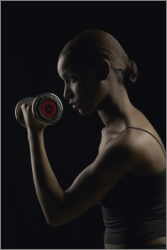Six Smart Steps to Create Stronger, Healthier Bones
by www.SixWise.com
Many people do not give a second thought to their bone health until they get older.
It's during these "golden years" that your bones may become more brittle
and prone to fracture. This is especially true for women, as up to 20 percent of
bone mass can be lost in the five to seven years following menopause. This increases
the risk of the bone disease
osteoporosis substantially, says the National Osteoporosis Foundation (NOF).
|

Weight-bearing exercises help build your bone density. Make sure to include strength
training that builds your upper body (weights) as well as your lower body (jogging,
kickboxing, etc.).
|
However, while some of your bone mass may be lost as you age, the best time to build
your bones, and set up your defense against this potentially debilitating disease
later, is actually during childhood and adolescence. In fact, by the time a woman
has reached the age of 20, she's already acquired about 98 percent of her skeletal
mass.
This certainly does not mean, though, that if you're over the age of 20 there's
nothing more you can do. There are steps you can take to strengthen your bones and
decrease your risk of osteoporosis no matter what your age, and we've listed some
of the best ones here.
1. Get Plenty of Weight-Bearing Exercise
Exercises like jogging, walking, yoga, kickboxing, weight lifting, and all forms
of strength training are essential to keep your bones strong.
"By stressing your bones, strength training increases bone density and reduces
the risk of osteoporosis," writes The Mayo Clinic.
2. Supercharge Your Diet With Plenty of Calcium, Vitamin K, and Vitamin D-Rich Foods
This includes fruits, vegetables (green leafy vegetables and broccoli are
great sources of calcium), dairy products and more. Remember that a healthy
diet is important for kids' bone health too! If you're concerned that your diet
isn't providing you with enough of the minerals your body needs, you may want to
try Gynofem
Osteoporosis Formula, an all natural multi-mineral and vitamin supplement
that has been shown to have a significant impact in preventing and reversing post-menopausal
bone loss, and has the added benefit of long-lasting effects in the increase of
bone density.
|
GynoFem Osteoporosis Formula for Optimal Bone Health
 GynoFem
is an all natural multi-mineral and vitamin supplement, specifically formulated
to prevent osteoporosis. Why GynoFem? GynoFem
is an all natural multi-mineral and vitamin supplement, specifically formulated
to prevent osteoporosis. Why GynoFem?
- It is the only supplement combining calcium citrate and magnesium oxide with vitamin
D for absorption and vitamin K for proper bone alignment.
- This special formula provides 1200 mg of calcium citrate and 600 mg of magnesium,
the highest recommended dosage, in the correct form, of calcium and magnesium, as
recommended by the National Institute of Health, the world's foremost authority
on osteoporosis.
- Gynofem contains no animal products, sugars, starch, corn antigens, dairy products,
wheat products, yeast products, fish oil, kelp, artificial colors, artificial flavors
or preservatives.
Learn
More About GynoFem Osteoporosis Formula's Benefits to Your Bone Health, and Order
Now!
|
3. Make Sure You're Getting Enough Vitamin D
Vitamin D helps your bones absorb calcium and phosphorus. If you don't get enough,
your bones will become weakened, yet government studies suggest that a growing number
of Americans are deficient in this important vitamin.
You skin makes vitamin D from sun exposure, and one of the primary reasons why people,
including kids, don't get enough is because they're not spending enough time outdoors,
or are wearing sunscreen when they do (which blocks vitamin D production).
"Standing outside 15 minutes a day three times a week lets the skin produce
enough vitamin D most of the year," says Dr. Michael Holick of Boston University.
Because people with dark-pigmented skin require more time in the sun to produce
vitamin D, they are especially at risk of vitamin D deficiency and, consequently,
bone problems.
Certain foods, such as milk and orange juice, are fortified with vitamin D, but
some natural health experts say the form of vitamin D used for fortification is
not ideal.
Foods that are naturally rich in vitamin D are fatty fish like salmon and, to a
lesser degree, mushrooms, organ meats and egg yolks.
4. Don't Smoke
Smoking increases bone loss, possibly by decreasing the amount of estrogen
a woman's body makes and by reducing the absorption of calcium in your intestine,
according to The Mayo Clinic.
|

Getting out in the sunlight everyday will ensure you have plenty of vitamin D, which
is crucial for helping your body absorb calcium and phosphorus. If you can't get
out in the sun, vitamin D3 supplements or vitamin-D-rich foods are an alternative.
|
5. Don't Drink Excessively
Drinking more than two alcoholic drinks a day is known to decrease bone
formation and reduce your body's ability to absorb calcium.
6. Manage Your Stress
Stress is regulated by adrenal hormones such as cortisol and DHEA. Studies have
proven that high cortisol levels (which is what makes you 'feel stressed') lead
to bone loss, while maintaining healthy levels of DHEA can prevent bone loss. Massage,
exercise, and meditation -- all of which are excellent for stress relief -- can
reduce elevated cortisol thereby reducing risks of bone loss.
How to Determine if Your Bones are Healthy
A bone mass measurement measures your bone density so you know if it's within the
normal range for your age or if you're at risk of a fracture. Your doctor can help
you determine whether a bone mass measurement (also called bone mineral density
or BMD test) is necessary, and you and your doctor can then determine the best course
of action to take to protect your bone health.
Recommended Reading
Calcium Better From Food, Says New Study: Here are the 26 Top Calcium Food Sources
Why is Rickets Disease Making a Comeback? A 21st Century Warning Tale?
Sources
MayoClinic.com Strength Training
MayoClinic.com Osteoporosis
National Osteoporosis Foundation